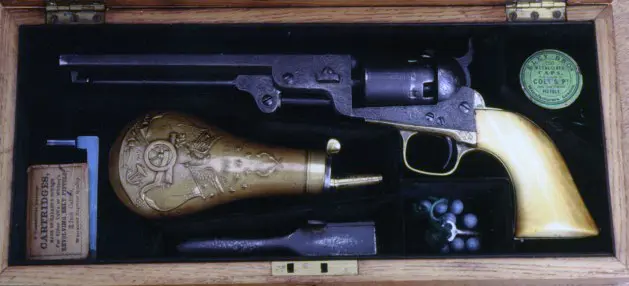How I got so involved in gun collecting
People often ask me how I got so involved in gun collecting, target shooting, hunting, etc. My answer is that we have a large and very close family with an interest in guns and sporting activities. My parents and numerous uncles and aunts always got together for a big picnic on the 4th of July. All of the many kids at these events were my first cousins and each of us got a new cap gun for every Independence Day celebration. Over the years, we all assembled quite an arsenal of cap guns. I still have my favorite one, and wish I still had them all. We often played cowboys and Indians in the woods adjacent to my house or on the farm belonging to my uncle, Mors Kirsch (MO for short).
My grandmother gave me a Red Ryder BB rifle, styled after the lever action Winchester for Christmas, when I was 10 years old. Needless to say, the BB rifle was my favorite Christmas present that year! By twelve years old my father was taking me hunting and I discovered that a 12 Gauge Shotgun could knock you on your butt or bruise your shoulder if you weren’t careful with stance and form. When I was 14, my Uncle “Mo” gave me an antique Double Barrel Percussion Pistol, which seemed to hook me for life on antique guns and their history.
Fast forward to 2008, I have been collecting primarily Civil War and Win-The-West pistols and revolvers that are positively identified or inscribed to a particular individual of po- tentially historical interest. Obviously, when you acquire guns that possibly fit the above description, you are “taking a gamble” be- cause some identified and/or inscribed guns end up at a dead end, where the historical evidence leads nowhere, but others lead to surprisingly exciting and adventurous stories, which are the primary subject of this display. In addition, my motivation and purpose is to encourage our members to research their identified guns and write their stories, so the rest of us can enjoy the tales just waiting to be discovered!
The procedure of investigating the history of a firearm
I enjoy my hobby and find it interesting and fulfilling to research these historic pieces of Americana and the lives attached to them. Doing the research is methodical, doesn’t appeal to some people, and often is not particularly profitable. But to me, it brings the guns alive and adds exponentially to the hobby or business of collecting. The procedure of investigating the history of a firearm is rather uniform, but also embraces a bit of creative thought and sometimes a lot of perseverance:
- You check the national archives and state archives for the potential war and pension records of the individual.
- Assuming you find records, you check the subject’s city and county courthouse records, historical society records and genealogy of the individual.
- You call the area where the subject lived and search for living descendants who may know a great deal about their ancestors.
- You contact the local libraries for information on the person and sometimes you are directed to contact local clubs like “Descendants of Union Soldiers Groups” or some other little known local club.
- In addition, you search the Internet genealogy and Civil War sites.
- Visit the area personally and ask around for historical As you continue to dig for information, it’s amazing how one thing leads to another and suddenly you develop a fairly thorough picture of the subject of your search. Sometimes I end up knowing more about a stranger than I know about my own Grandfather.
The true story of the cased M1851 Navy Colt
As an example of one of the most exciting, rewarding, and profitable finds of my lifetime, I’ll tell you the true story of the cased M1851 Navy Colt, factory engraved with factory original ivory, grips that is one of the 12 guns included in this display. The back strap is inscribed, “Presented to Col. J. Warner By the officers of 108th Ill.”
Fortunately, Col. John Warner applied for a pension for Civil War injuries, which gave me a great amount of information to study. On vacation my wife, Sharon, and I were going through Peoria, Col. John Warner’s home- town. Walking into the courthouse, I asked the receptionist if she ever heard of Colonel John Warner? She said, “Yes, his picture is hanging in our council chambers with the other Mayors! Incidentally, he served as Mayor for 16 years and was, by reputation and accomplishments, considered Peoria’s greatest Mayor.”

Cased M1851 Navy Colt
“Wow,” I said, “What all did he do for Peoria?” She answered, “Many things including the first paved streets, the first city fire department, the first public library, regulation uniforms for the police, built Peoria’s third city hall, and lastly a new jail.” “By the way,” she said, “Go across the street to our main library and you will find a full two-page obituary for Col. Warner in the Peoria Star News- paper.”
The Librarians were most helpful and produced a copy of his December 28, 1920 obituary for me that was approximately 8,000 words on every detail of Warner’s life including the unimaginable fact that his great grandmother was Betty Washington, George Washington’s only sister. Colonel Warner’s death occurred on December 28, 1920 at the age of 94. His body lay in state at city hall from 9:30 am to 1:30 pm on December 31st. As a final honor and testimonial to his great- ness, when Peoria built the city’s first Federal housing project in 1941 they named it “Colonel John Warner Homes.”


